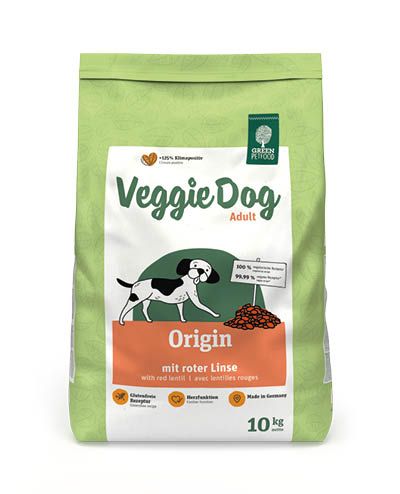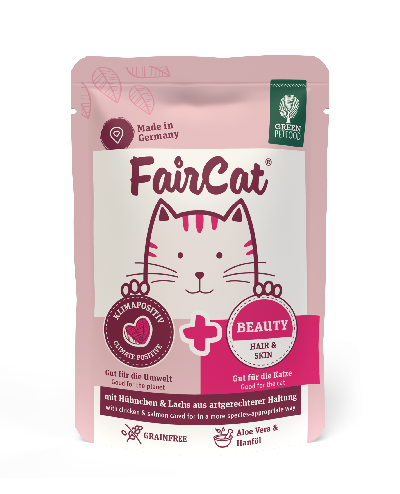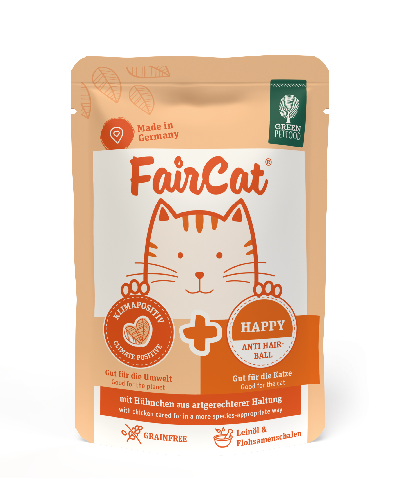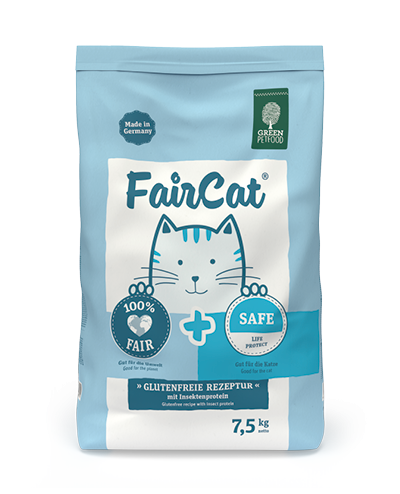What fruits and vegetables can dogs and cats eat?
Fruit and vegetables are important components in these animals' diets. In addition to vitamins and minerals, they supply important fibre, which helps promote healthy gastrointestinal function and supports the immune system. Funny pictures of dogs biting greedily into melons are widespread. Why look so far afield when there is so much close at hand? We have compiled a seasonal calendar of fruit and vegetables to help you feed your favourite pet – all from local sources that do not involve transporting products halfway around the globe.
What do I need to know about feeding fruits and vegetables to dogs and cats?
Vegetables are contained in most dry and wet food varieties. In our Green Petfood products, for example, you will find potatoes, peas or red lentils. If your pet is on a BARF diet, you should make sure fruit and vegetables are on the menu to ensure all nutritional needs are met. Whatever your pet's basic diet looks like: they are bound to enjoy a piece of fruit or a vegetable snack.
To make sure your dog or cat can digest the vegetables properly, you can purée or gently steam them first. But some kinds of fruit and vegetables can also be offered raw. A rough rule of thumb is that vegetables which humans can only eat when cooked should also not be offered raw to cats or dogs.
Not all pets can tolerate different kinds of fruit and vegetables equally well. In addition to choosing between varieties, it is important to get the quantity right. You should ideally only offer snacks in this form in small quantities, and take a cautious approach. Some fruit and vegetables are high in calories. If you give your pet this kind of treat, make sure you reduce their daily quantity of food accordingly.
Do cats enjoy eating fruit and vegetables as much as dogs?
Our feline friends are generally less keen on plant-based snacks than dogs. Why is that?
Dogs have now lived alongside humans for thousands of years and have adapted their lifestyle to suit. Compared to wolves, dogs are much better equipped to digest starchy food. This means they are able to consume and metabolise plant-based nutrients. Just think back to the time of our ancestors, when dogs would have eaten leftovers from the table or grain from the fields. Domestic dogs have now become omnivores.
Cats, meanwhile, are pure carnivores, even if their wild relatives also consume the stomach contents of their prey. Since their diet consists mostly of animal protein, cats only need small quantities of vegetables.
What vegetables can dogs eat?
Dogs can eat all sorts of vegetables, many of which are grown in our native fields. Let us tell you which kinds these are and how to feed them.
- Leafy vegetables: lettuce, endives and lamb's lettuce are suitable for dogs. They have a high water content and contain lots of vitamins and minerals. They also provide fibre for a well-balanced intestinal environment.
- Chicory: is a natural source of insulin and contains vitamin C, potassium, calcium, magnesium and phosphorous. It is very healthy for dogs, but unfortunately its bitter taste means it is not very popular.
- Cucumber: lots of pets will find cucumber to be thoroughly nutritious and delicious. Cucumbers have a very high water content and ensure your dog consumes extra water. However, cucumbers can cause poisoning symptoms if they contain cucurbitacin. These are bitter substances that can occur in plants in the gourd (or cucurbit) family, such as cucumber or courgette. These are toxic for humans and animals. Cucumbers that are cultivated for consumption do not normally contain any cucurbitacins. However, cucumbers you have grown in your own garden may contain this substance. If a cucumber contains cucurbitacin, it will taste bitter. In this case, it should not be eaten. If you want to feed your dog with cucumber from your own garden, just taste it first. If the cucumber tastes normal, you can safely offer it.
- Peas (green): peas belong to the legume family. They should always be cooked before eating. If offering peas, you should always make sure they can be tolerated.
- Carrots: carrots are high in fibre and contain large quantities of provitamin A (beta-carotene). This vegetable enjoys high acceptance, so it can be offered fresh or cooked.
- Potatoes: potatoes are a particularly good choice for dogs with allergies or intolerances. They contain carbohydrate, protein, fibre, vitamins, sodium, calcium and phosphorous. They are difficult to digest when raw so should always be cooked first. Green areas are toxic and should be removed.
- Cabbage: cauliflower, broccoli, Brussels sprouts, white cabbage and savoy cabbage all belong to the Brassicaceae family (cruciferous vegetables). In addition to containing glucosinolates, they also contain a certain amount of SMCO (S-Methylcysteine sulfoxide). These substances can be harmful to the liver and kidneys. For this reason, these vegetables should never be eaten raw. Many varieties of cabbage also offer differing levels of indigestible sugar (raffinose, stachyose) which can cause flatulence and stomach ache even when cooked. The quantity that an animal can tolerate should be tested on a case-by-case basis.
- Pumpkins: pumpkins contain vitamins A, C, D and E. The flesh contains potassium, calcium and zinc. They also supply lots of beta-carotene. Pumpkins stimulate the digestive system, reduce inflammation and strengthen the immune system. So they are very healthy for dogs. Pumpkins should only ever be offered cooked.
- Swiss chard: Swiss chard is rich in protein and minerals. It is best to gently steam this vegetable before feeding it to your dog. Because Swiss chard contains oxalic acid, it should not be fed to dogs with a tendency to develop urinary stones or to growing dogs.
- Bell peppers: see tomatoes
- Beetroot: beetroot contains high levels of oxalic acid. The oxalate content can be significantly reduced through cooking. The cooking water should not be given to your dog. If your dog is susceptible to urinary stones (calcium oxalate stones), beetroot should be avoided completely. Due to the high levels of oxalic acid, beetroot should only be eaten in very small quantities and is best avoided for dogs that are growing. Note: beetroot is rich in fibre and thus helps support the intestinal system. If fed in larger quantities, this can result in stomach problems e.g. flatulence.
- Salsify: this root vegetable is an excellent addition to your dog's daily diet. The roots act as nutrient-rich storage organs, which makes them ideal for consumption.
- Spinach: spinach is another vegetable that contains relatively high levels of oxalic acid. The same information applies here as for beetroot. Spinach contains lots of vitamins and minerals. In fresh spinach, the stalks and leaf veins must be removed. These contain nitrate. This is converted into harmful nitrites in the dog's body.
- Turnip: turnips contain lots of nutrients and are low in calories. They contain vitamin C, calcium, potassium, magnesium, beta-carotene, iron, provitamin A and vitamins B1 and B2. This is an incredibly healthy vegetable for dogs.
- Tomatoes: these red fruit are part of the nightshade family. The solanine formed from them can result in diarrhoea and vomiting. However, the cytotoxin solanine is only found in the green parts of the plant and the unripe fruit. Consequently, you should avoid raw, unripe tomatoes and their green sections.
- Courgettes: courgettes contain potassium, calcium, magnesium and phosphorous, which makes them healthy for dogs and easy to digest.
What kind of fruit can dogs eat?
Unlike some types of vegetable, berries and apple do not need to be cooked. Dogs can tolerate lots of kinds of fruit in smaller quantities with no problem, and will enjoy eating them.
- Apples: apples contain lots of minerals and trace elements plus important vitamins like provitamin A, vitamins B1, B2, B6, E and C, niacin and folic acid. The pectin in ripe apples helps regulate the digestive system.
- Pears: pears belong to the rose family. They contain valuable vitamins and minerals. Small quantities are very well tolerated by dogs. You should be careful only to offer fruit that are completely ripe.
- Blackberries: blackberries are rich in tannins and contain flavonoids, mucilage and vitamins. They were popular medicinal plants as early as Roman times. The berries are rich in vitamins and are said to have a high antioxidant potential.
- Strawberries: the vitamin B contained in this fruit ensures better powers of concentration and a glossy coat, while the sodium binds to acids. Strawberries are rich in vitamin C and are sweet, which means they are scoffed enthusiastically by most dogs.
- Rosehips: rosehips are the fruit of the wild rose and contain vitamin C, carotenoids, pectin and tannic acid. They are said to have an antioxidant and anti-inflammatory effect. Since they are not widely cultivated in Germany, these are best sourced from your own garden.
- Blueberries: blueberries are a low-calorie snack. They are rich in vitamin C, fibre and antioxidants, which strengthen the immune system. Since they are relatively low in sugar compared to other fruit, even dogs with diabetes can enjoy these delicious berries.
- Raspberries: raspberries are the ideal snack between meals because they can simply be eaten raw. Raspberries are thought to help combat rheumatism, constipation, diarrhoea and gastroenteritis. They also contain lots of vitamins.
- Blackcurrants: these belong to the Grossulariaceae family and are cultivated in Europe, Asia and North America. These very bitter berries contain vitamin C and the antioxidant anthocyanin.
- Lingonberries: lingonberries are part of the Ericaceae family and are found in the northern hemisphere. They contain anthocyanin (which can combat free radicals), vitamins and minerals. They are also thought to have an antibacterial effect. Since they are not widely cultivated in Germany, these are best sourced from your own garden.
- Sea buckthorn: this is a member of the oleaster family and grows in sandy soil along the Baltic coast, amongst other places. Sea buckthorn berries are rich in vitamins, carotenoids and tannins.
- Stone fruit: cherries, plums and apricots are suitable for dogs. It is essential to remove the stones before feeding or puréeing because these contain hydrocyanic acid.
What seasonal fruits and vegetables can cats eat?
Most pussycats want nothing to do with plant-based snacks. Here you will find a brief overview of regional fruit and vegetable varieties that your cat can eat.
- Peas (green): peas belong to the legume family. They should always be cooked before eating. If offering peas, you should always make sure they can be tolerated.
- Carrots: carrots are high in fibre and contain large quantities of provitamin A (beta-carotene). This vegetable enjoys high acceptance, so it can be offered fresh or cooked. Carrots are best finely grated or puréed.
- Pumpkins: pumpkins contain vitamins A, C, D and E. The flesh contains potassium, calcium and zinc. They also supply lots of beta-carotene. Pumpkins stimulate the digestive system, reduce inflammation and strengthen the immune system. Pumpkins are very rich in fibre and will help your cat digest its food properly. Always cook the pumpkin beforehand until soft.
- Spinach: spinach is equally healthy for dogs and cats. With vitamins A, C and K, plus calcium and iron, spinach is incredibly healthy for both animals.
Why are aronia berries, blackcurrants and blackberries not suitable for cats?
In order to excrete the phenols contained in these plants (and their components), these first have to be detoxified in the liver. For physiological reasons, cats are deficient in the necessary enzyme for this process. Consequently, repeated consumption of berries or plant components containing phenols can result in a toxic build-up of these substances in the body. This can result in liver and kidney damage.
Seasonal fruit and vegetables for cats and dogs – the key information
By shopping seasonally and locally, we are supporting our local farmers and minimising CO2 emissions due to shorter transportation distances. And your pet can enjoy lots of delicious kinds of fruit and vegetables as a snack! As omnivores, dogs have a clear advantage here and are able to consume a much wider range of treats than cats. It doesn't matter what kind of fruit or vegetable you are offering, generally anything that humans can only eat in cooked form should also not be offered raw to cats or dogs. If you are not sure, it is best to purée or steam the snack before feeding it to your pet. Always make sure you offer a very small quantity first and watch carefully to see how your pet reacts to the snack. Apart from that, they are free to enjoy a delicious treat!















